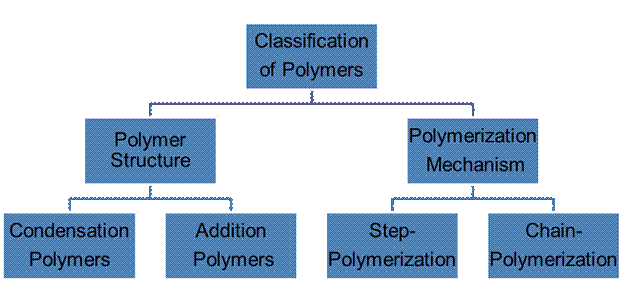Condensation polymerization
Kazakh National University name after al-Farabi
Chemistry and Chemical Technology Faculty
SIW#3
by discipline SURFACTANTS AND POLYMERS ADSORPTION
GENERAL CHARACTERISTICS OF POLYMERS. METHODS OF MACROMOLECULAS SYNTHESIS. POLYMER ADSORPTION ON THE INTERACES. KINETICS AND EQUILLIBRIUMS (ISOTHERMS OF ADSORPTION).
Student: ASSYLKHAN ZHUMAT
Major: Chemical technology of organic substances
Group: 401
Almaty, 2016-2017
Polymers are long chain giant organic molecules are assembled from many smaller molecules called monomers. Polymers consist of many repeating monomer units in long chains. A polymer is analogous to a necklace made from many small beads (monomers). Another common name for many synthetic polymers is plastic which comes from the Greek word "plastikos", suitable for molding or shaping. Many objects in daily use from packing, wrapping, and building materials include half of all polymers synthesized.
Characteristics of polymers.
ü Low Density.
ü Low coefficient of friction.
ü Good corrosion resistance.
ü Good mould ability.
ü Excellent surface finish can be obtained.
ü Can be produced with close dimensional tolerances.
ü Economical.
ü Poor tensile strength.
ü Low mechanical properties.
ü Poor temperature resistance.
ü Can be produced transparent or in different colours

Polymer synthesis proceeds with the polymerization of monomer units .
Polymerization : The process of linking the repeating units (monomers) is termed as polymerization

Type of Polymerization:
Addition or chain polymerization Addition Polymers - the monomer molecules bond to each other without the loss of any other atoms. Alkene monomers are the biggest groups of polymers in this class.
Condensation or step polymerization Condensation Polymers - usually two different monomer combine with the loss of a small molecule, usually water. Polyesters and polyamides (nylon) are in this class of polymers. Polyurethane Foam in graphic.
Addition polymerization
Self addition of several bifunctional monomers to each other takes place by chain reaction without the elimination of any simple molecules.
GENERAL REACTION:
n [CH2=CH] à [-CH2-CH-]n
Condensation polymerization
Self addition of several bifunctional monomer to each other takes place accompanying elimination of simple molecues like H2O,NH3 & HCL
General reaction:
n[HOOC-X-COOH] + n[HO-Y-OH] = HO-[….OC-X-COO-Y-O]n-H + (2n-1)H20
Polymer Structure
Addition polymers are those formed from monomers without the loss of a small molecule.
The major addition polymers are those formed by polymerization of monomers containing carbon-carbon double bond; such monomers are called vinyl monomers or substituted ethylenes.

Condensation polymers whose repeating units are joined together by functional units such as ester (-OCO-), amide (-NHCO-), urethane (-OCONH-), sulfide (-SO2-) and other linkages.
-R-Z-R-Z-R-Z-R-Z-R-Z-
R is aliphatic or aromatic grouping and Z is functional unit
Polymer adsorption. Kinetics and equilibriums (isotherms of adsorption).One of the defining features of polymer surfaces and coatings is the chemical regularity of the surface. While many materials can be irregular mixtures of different components, polymer surfaces tend to be chemically uniform, with the same distribution of different functional groups across all areas of the surface. Because of this, adsorption of molecules onto polymer surfaces can be easily modeled by the Langmuir or Frumkin Isotherms. The Langmuir equation states that for the adsorption of a molecule of adsorbate A onto a surface binding site S, a single binding site is used, and each free binding site is equally likely to accept a molecule of adsorbate:
{\displaystyle A+S\leftrightharpoons A-S} 
where:
{\displaystyle A}A -is the adsorbate
{\displaystyle S}S - is the surface binding site
A-S -{\displaystyle A-S}SSs is the bound adsorbate/binding site pair
The equilibrium constant for this reaction is then defined as:
{\displaystyle k_{ad}={\frac {[A-S]}{[A][B]}}} 
The equilibrium constant is related to the equilibrium surface coverage {\displaystyle \theta }  , which is given by:
, which is given by:
 {\displaystyle \theta \ ={\frac {k_{ad}[A]}{k_{ad}[A]+1}}}
{\displaystyle \theta \ ={\frac {k_{ad}[A]}{k_{ad}[A]+1}}}
where:
{\displaystyle \theta }  - is the surface coverage (fraction, 0 is empty, 1 is fully covered)
- is the surface coverage (fraction, 0 is empty, 1 is fully covered)
{\displaystyle k_{ad}}  - is the adsorption equilibrium constant
- is the adsorption equilibrium constant
Because many polymers are composed of primarily of hydrocarbon chains with at most slightly polar functional groups, they tend to have low surface energies and thus adsorb rather poorly. While this can be advantageous for some applications, modification of polymer surfaces is crucial for many other applications in which adhering a substrate to its surface is vital for optimal performance. For example, many applications utilize polymers as structural components, but which degrade rapidly when exposed to weather or other sources of wear. Therefore, coatings must be used which protect the structural layer from damage. However, the poor adhesive properties of nonpolar polymers makes it difficult to adsorb the protective coating onto its surface. These types of problems make the measurement and control of surface energies important to development of useful technologies.
The Gibbs energy of adsorption, {\displaystyle \Delta G_{ad}}  , can be determined from the adsorption equilibrium constant:
, can be determined from the adsorption equilibrium constant:

{\displaystyle \Delta G_{ad}=-RTln(K_{ad})}Because  {\displaystyle \Delta G_{ad}} is negative for a spontaneous process and positive for a nonspontaneous process, it can be used to understand the tendency for different compounds to adsorb to a surface. In addition, it can be divided into a combination of two components:
{\displaystyle \Delta G_{ad}} is negative for a spontaneous process and positive for a nonspontaneous process, it can be used to understand the tendency for different compounds to adsorb to a surface. In addition, it can be divided into a combination of two components:
{\displaystyle \Delta G_{ad}=\Delta G_{p}+\Delta G_{c}} 
which are the Gibbs energies of physisorption and chemisorption, respectively. Many polymer applications, such as those which use polytetrafluoroethylene (PTFE, or Teflon) require the use of a surface with specific physisorption properties toward one type of material, while being firmly adhered in place to a different type of material. Because the physisorption energy is so low for these types of materials, chemisorption is used to form covalent bonds between the polymer coating and the surface of the object (such as a pan) which holds it in place. Because the relative magnitudes of chemisorption processes are generally much greater than magnitudes of physisorption processes, this forms a strong bond between the polymer and the surface it is chemically adhered to, while allowing the polymer to retain its physisorption characteristics toward other materials.
Experimentally, the enthalpy and entropy of adsorption are often used to fine-tune the adsorption properties of a material. The enthalpy of adsorption can determined from constant pressure calorimetry:
{\displaystyle Q=-\Delta H_{ad}*N} 
where:
{\displaystyle Q}  Q - is the heat exchanged
Q - is the heat exchanged
 - {\displaystyle \Delta H_{ad}} is the integral molar enthalpy of adsorption
- {\displaystyle \Delta H_{ad}} is the integral molar enthalpy of adsorption
{\displaystyle N}N - is the number of moles adsorbed.
REFERENCES
· Adsorption of polymers anchored to membranes
M. Breidenich, R.R. Netz, and R. Lipowskya, The european physical journal, Potsdam, Germany